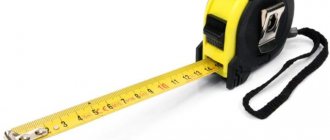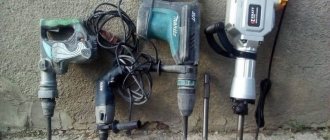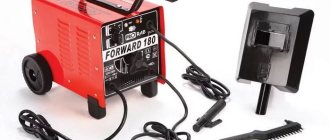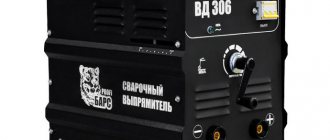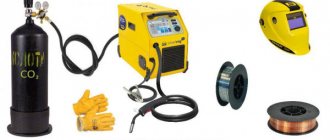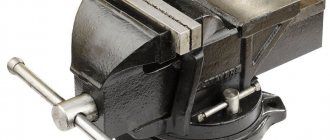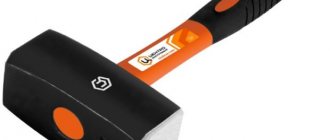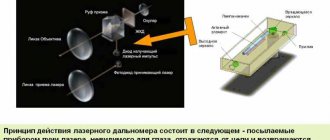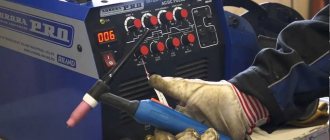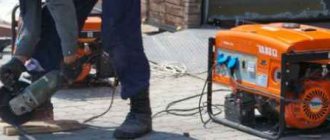It is quite possible for a summer resident, the owner of a private house or garage, to carry out welding work on his own. The choice of the type of household welding machine depends on what and how you want to reliably connect.
Consultations and advice from sellers will, of course, help you navigate the variety of commercial offers. However, the buyer's personal awareness and the most basic knowledge will help to ask the right questions and understand the answers to them.
In this article you will find basic information about what welding is and what the operating principle of the welding machine is based on.
What is welding?
The process of permanently joining several parts into a single whole through heating, deformation and the use of filler materials (electrodes) is called welding.
The materials of the solid components being joined are heated to the point where intermolecular or interatomic bonds occur at the welding site. A similar effect can be achieved by applying pressure to the surfaces at the desired joint.
The combination of pressure and heat allows the welding process to be optimized and controlled. Moreover, the higher the temperature, the less pressure is required. When the melting temperatures of the materials of the parts being joined are reached, the need for pressure on them completely disappears.
The welding method, being dependent on a number of factors, influences the choice of welding equipment.
In this article we are not talking about industrial, but about household welding machines that can be bought in stores. Therefore, we will limit ourselves to a description of equipment that implements the principle of electric arc welding, and semi-automatic welding machines that require a gas environment for welding.
Additional functions in inverters
Modern inverter devices implement some options that significantly facilitate the welder’s work:
- Hot start - often novice welders, and not only them, have difficulty igniting and maintaining the arc in working condition. At the moment of ignition, the current rises to the required level and immediately after ignition returns to operating parameters. The process of changing the current occurs completely automatically, without the participation of the welder.
- Another problem that plagues beginners is electrode sticking. There are several reasons for this, but there is only one solution - reducing the level of welding current. This operation is also performed automatically.
- Arc forcing allows you to make seams in different spatial positions.
- Reducing the no-load voltage to a level that is safe for the worker and his surrounding people.
Operating principle of a welding transformer
Welding machines of this type operate on alternating current, the strength of which is regulated by changing the voltage using a step-down transformer. As a result, reliable power is provided to the welding arc, the temperature of which can be several thousand degrees Celsius.
In most designs, reducing the voltage to the level required to maintain the stability of the welding arc is achieved by moving one of the windings along the magnetic core. The resulting operating voltage, as a rule, does not exceed 80V with initial levels of 220-380V. The inductive resistance of the windings changes and thus regulates the amount of welding current.
In addition to this, designs with a moving magnetic shunt or thyristors are also used.
Purpose of welding machines
To perform welding, you need a special tool - a welding machine. One of the latest types of such devices is the inverter. In its main characteristics it surpasses its predecessors. Welding inverters are more functional, compact and easy to use. They are preferred by both professionals and ordinary amateurs who use welding at home.
In most cases, welding is used to connect metal parts of a product. It can also be used for materials such as ceramics, or for bonding plastics. The type of machine will depend on what metal or non-metal you will be welding and how strong the seam of this joint must be.
Operating principle of a welding inverter
The welding inverter converts voltage and normal alternating current (frequency 50 Hz, mains voltage 220V) to the values necessary for the formation and maintenance of a welding electric arc.
Schematically it happens like this:
- First, the alternating current is converted into direct current using a primary rectifier. To reduce the voltage from 220V to the required level, an inverter unit is used, in which the direct current becomes alternating again, but high-frequency, like the voltage.
- In the transformer, the resulting high-frequency voltage is reduced to an optimal value. As a result of these transformations, the current strength increases significantly.
- After voltage optimization, the high-frequency alternating current is converted to direct current for a second time. Next, its strength is adjusted to the required values.
Thus, in the welding inverter, the current and voltage are clearly controlled. This allows you to smoothly adjust their levels and perform a wide range of welding jobs to connect parts even from the most refractory metals and alloys.
The feasibility of using inverters and their main disadvantages
The widespread use of welding inverters is explained by a number of significant advantages that they possess.
- Devices of this type are characterized by high power and performance.
- The weld seam formed using inverters is characterized by high quality and reliability.
- Along with high power, devices of this type are compact in size and light in weight, which makes them easy to transport to the place where welding work will be performed.
- Welding inverters have a high efficiency (about 90%), the consumed electrical energy is used in them more efficiently than in transformers.
- Due to their high efficiency, such devices are characterized by economical consumption of consumed electricity.
- In the process of welding work using an inverter, the molten metal splashes slightly, which is reflected in a more rational consumption of consumables.
- Inverters provide the ability to smoothly adjust the welding current.
- Due to the presence of additional options in such devices, the skill level of the welder has almost no effect on the quality of the work.
- The wide versatility of inverters eliminates the question of which machine to choose for welding using various technologies.
Inverter devices are chosen when you need a device whose characteristics ensure high stability of the welding arc in any situation. When using inverters, the question does not arise about which electrode to choose for welding work, since with the help of this equipment you can weld metal with electrodes of any type.
Of course, inverters also have disadvantages, but there are not many of them. This should include the rather high cost of such devices compared to conventional welding transformers. Such devices are also expensive to repair, which is most often associated with the need to replace powerful transistors (their cost can be up to 60% of the price of the entire device).
Inverters are very sensitive to negative external factors - dust, dirt, precipitation and frost. If you need an inverter for work in the field, you will have to build a closed and heated area for it.
Operating principle of semi-automatic welding machine
Electrodes are not needed here. Because the semi-automatic welding machine uses a special welding wire that melts in a gaseous environment.
To make it easier to understand what a semi-automatic welding machine is, it is enough to know that it is a unit that includes:
- Power source, which can be a welding inverter or a welding rectifier
- Welding wire feeder
- Welding torch
- Control system
- Connecting cables and hoses
The welding wire flows smoothly and correctly into the welding torch through a special device. Pure carbon dioxide or its mixture with argon is also supplied to the welding site.
So, to the above components of the installation, it is logical to add special gas-containing containers, as well as reels with wound welding wire.
We hope that information on what the principle of operation of a welding machine is based on, depending on its type, will help you better understand the consumer characteristics of this necessary equipment for everyday life and make the best choice.
Pros and cons of inverter welding
Inverter devices show efficiency in the range of 85 - 95%, I must say that this is a high figure among electronic equipment. The circuit used allows you to adjust the level of welding current from several amperes to hundreds, or even thousands.
For example, an inverter of the MMA brand, it is 20 - 220 A. Inverters can operate for a long time. The power supply can be controlled remotely. The undoubted advantages of inverters include their small size and weight characteristics, which allow the device to be moved at the welding site. The design of the devices uses double insulation, ensuring electrical safety.
Technological advantages
The use of inverters allows the use of electrodes of any brand that work with both direct and alternating current. Devices of this type can be used for welding with a non-consumable electrode in a shielding gas environment. In addition, the design of this equipment makes it easy to automate welding processes.
Tungsten electrodes for argon arc welding
Electrodes for resistance welding
Welding can be performed using a short arc, thus reducing energy losses and increasing the quality of the weld; in particular, there is virtually no welding spatter on the surface of the parts being welded. By the way, the use of inverters allows you to produce seams in any spatial configuration.
Microprocessor
Microprocessors are used to control modern welding inverters, and this ensures a stable connection between voltage and current.
Disadvantages of inverters
Inverters are somewhat more difficult to repair than traditional transformer units. If some control elements located on the board fail, repairs can cost about a third of the cost of a new welding inverter.
Inverters, unlike other types of equipment, are very susceptible to dust. That is, such devices must be serviced more often. Operation of an inverter welding machine is also limited by low temperatures. In addition, there are some restrictions on storing the inverter at sub-zero temperatures. This is fraught with the formation of condensation, which can lead to a short circuit on the board.
Homemade crafts are alive and well
Creating a personal energy-independent unit based on a purchased 4 kW generator and a home-made or ready-made welding machine is justified and advisable. The idea of mobility and autonomy should be complemented by:
- Install additionally to expand the generator function 1–2 sockets;
- Enclose the equipment in all-weather removable cases made of plastic or metal;
- Organize additional cooling with a fan;
- Place the block on the wheels.
Current control
The inverter welding current is regulated using an electronic feedback controller shown in the diagram. Using the potentiometer located on the front panel of the welding inverter, the required welding current value is selected.
When the potentiometer knob is rotated, a certain reference voltage level is established at the input of logic elements built on operational amplifiers.
The signal coming through the feedback line from the current sensor located at the output of the device is compared by a comparator with the level of the voltage set by the control potentiometer.
If the voltage levels of the master circuit and the current sensor signal do not match, the amplitude of the control pulse supplied to the controller changes.
In this case, the duty cycle of the pulses generated by the controller changes, which causes a change in the switching mode of the transistors and, ultimately, the value of the welding current.
That is, the regulation principle is that the circuit always strives to maintain correspondence between the values of the specified and actual current, which ensures its stability.
The TL494 microcircuit, produced by the American company Texas Instruments, or its analogues is usually used as a controller that generates adjustable pulse-width modulation signals.
The given block diagram shows only the principle of operation and interaction of individual functional blocks. The detailed electrical circuit of each type of inverter may have individual characteristics.
Advantages of inverter technology
The superiority of welding inverters over classic transformer-type converters is visible both in technological and economic aspects.
If we briefly list the benefits gained by introducing an inverter, we get something like this:
- higher efficiency, exceeding 90%, which predetermines the design of the welding inverter itself, characterized by the absence of magnetic losses in the steel core of the transformer, inherent in the “classics”;
- ability to work under conditions of varying supply voltage levels over a wide range without reducing technological parameters;
- the ability to very accurately set the welding current with a digital indication of its value and strictly maintain the level during the welding process;
- radically reduced overall dimensions and weight of the structure;
- a whole range of completely new features inherent only in inverter devices, here are just a few of them.
New features include the presence of specific functions, including hot start, anti sticking, arc force, and others, making the welding process accessible even to a beginner. It is possible to use electrodes designed for welding with both alternating and direct current.
As for the commonly mentioned disadvantages inherent in this type of equipment, first of all, we are talking about the relatively high price of these devices.
The following can be said about this. Remember how the prices of new computer and mobile products have changed literally over the course of several years. Further improvement of technology and increased mass production will inevitably lead to a significant reduction in prices for welding inverters.
Electric arc
Temperatures of thousands of degrees Celsius are provided by an electric arc, which is essentially a short circuit between two electrodes located quite close to each other. The voltage applied to the electrodes increases until there is a breakdown of the air, which is an insulator.
Breakdown is the emission of electrons from the cathode. The electrons heated by the current come out and are directed to the ionized atoms of the anode. Then a discharge appears, the air in the gap is ionized, plasma is formed, the resistance of the air gap decreases, the current increases, the arc heats up, and becomes a conductor and closes the circuit. The process is called “ignition” of the arc. The arc is stabilized by establishing the required distance between the electrodes and maintaining the power supply characteristics.
Electric welding machine for home and garden
For everyday use, an inexpensive inverter with an optimal duty cycle of 60% is selected. It is often used by professionals because with leisurely operation and a small operating current, the device can be switched on continuously. It is important here that the mains voltage is normal. In this case, a device with a power of up to 160 A is selected. Welding 220 volts, with a current of up to 200 A, is advisable when frequent surges in the mains voltage occur. From 180 A and above, it is possible to weld sheets up to 5 mm thick with an electrode with a diameter of 4 mm.
Design and device
Structurally, the units are divided into categories:
- According to the installation type - wheeled, on a loading platform, self-propelled with the addition of lifting mechanisms;
- By type of power drive - diesel, gasoline;
- Industrial and household;
- By category of electrical installations – valve, manifold.
Free access to components and mechanisms for maintenance and repair is provided through hinged doors and removable curtains. In some cases, it is planned to equip the station with additional gas-cylinder equipment in isolated compartments and instruments.
Professional installations are focused on non-stop operation with periodic short-term technological breaks.
The energy supply of industrial installations varies 220/380 V. Household ones are limited to a voltage supply of 220 V.
Diesel engines have a power reserve and are capable of delivering up to 500 kW. Gasoline - maximum 15 kW.
Fundamental differences between settings:
- welding transformers;
- welding rectifiers;
- welding inverters;
- semi-automatic equipment.
Unpretentious autonomous ADD units on a chassis
The designers took the path of simplification and reduction in cost. The single-post installation is mounted on a 2–4-wheeled chassis in a solid frame with a channel strap, covered with a casing to suppress noise and protect it in bad weather. Provides energy to a professional welding machine . It is possible to connect other electrical equipment and tools.
The manufacturer, for the sake of reliability of the equipment, excluded electronics.
Result:
- Operation at 98% humidity is acceptable.
- Operating temperature range –45–+450 C.
The 4-cylinder diesel engine is cooled by air flow, an additional measure to prevent engine damage. Current adjustment is available in coarse stepwise, smooth, remote with a distance of up to 20 m. 3-step control ranges:
- 60–165 A;
- 150–320 A;
- 300–430 A.
The DC generator ensures ignition stability, combustion maintenance, and arc elasticity. Qualitative superiority over collector-type diesel generators has been confirmed.
Operating voltage 36–100 V. Electrode size limited to Ø 6 mm.
The unit is adapted for hooking and transportation by vehicles or tractors over rough terrain. The volume of the fuel tank is sufficient for continuous operation throughout the day. At sub-zero temperatures, the fuel network warms up automatically. In bad weather, the work site is covered with a polypropylene waterproof tent.
Characteristics of ADD welding units on a single-axle trolley:
| Brand | Diesel | Fuel consumption | Current range | Type of cooling | Weight, dimensions |
| ADD-4004P | 37 kW, 1800 rpm | 4.4 kg/h. | 60–450 A | Air | 1.03 t, 1.68x1.93x2.85 m |
| ADD-4001 | 36.8 kW, 1800 rpm | 5.2 l/hour | 45–430 A | Air | 0.82 t, 1.0x1.3x224 m |
Features of welding using an inverter
The devices have three functions.
- Hot start. In the initial period, the current increases and the electrode does not need to be heated, like a transformer. When started, the arc becomes more powerful, and welding occurs successfully.
- Anti-sticking – an increase in operating current when the electrode sticks. As a result, rapid separation occurs and welding parameters are instantly restored.
- Arc forcing. The parameters of the welding current in the anti-stick mode are adjusted so that the metal does not spatter too much.
How to choose?
Stationary, portable and mobile welding units are selected based on the operating conditions and purposes. The range of devices on the market is very extensive. Experts recommend giving preference to brands from Europe, the USA, Russia and China. You should trust well-known and experienced manufacturers with a good reputation, who honestly indicate its real parameters in the equipment passport.
Before making a purchasing decision, it is important to provide detailed answers to the following questions:
- For what operating conditions is the equipment purchased?
- What are the volumes and quantity of the proposed work?
- What metals do you need the machine to process?
- How important are the parameters of weight, mobility and ergonomics of a tool?
If the device is needed for professional work with different metals and in different conditions, you should give preference to a universal welding unit with a wide range of characteristics. For domestic purposes, there is no point in buying expensive and powerful equipment. An economical AC installation can handle this task quite well.
For operation in cold climates, it is better to purchase equipment with a gasoline engine, since it is easier to start at low temperatures. It is also worth considering that diesel units are safer and more economical, which is important for facilities where the use of flammable substances is possible. When choosing any model, you should definitely pay attention to the availability of components, warranty and service.
